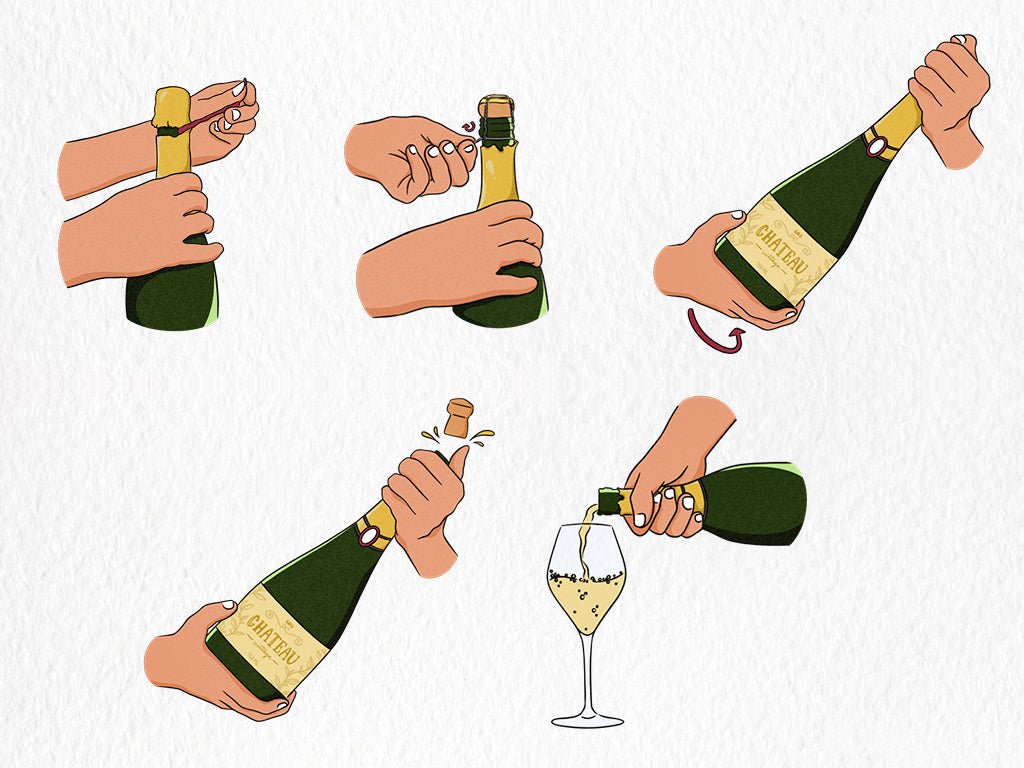With Coravin Sparkling (coming late summer 2021), we plan to change the way the world experiences all wine – including bubbly. The Coravin Sparkling™ Sparkling Wine Preservation System preserves the crisp flavor and effervescence of your favorite sparkling wines for a month, ensuring that – just like Timeless and Pivot – the last glass will taste as amazing as the first.
If you’re new to sparkling wine, let this article be your guide. We’ll explain what makes sparkling wine special, how to open a sparkling wine bottle, and how to pair bubbles with food.
What is sparkling wine
Sparkling wines are carbonated and usually include small amounts of added sugar. Carbonation decreases the body in wine, which is why sparkling wines are usually light and refreshing – pairing well with heavy, fatty foods (more on that later). Classic sparkling varieties include Prosecco (Italy), Cava (Spain), Crémant (France), Champagne (France), Riesling Sekt (Germany/Austria), and Franciacorta (Italy). You’ll also find sparkling rosés and reds like Lambrusco.
When it comes to sugar, sparkling wines typically have added concentrated grape must – a natural ingredient obtained from pressed grapes. On the label, you’ll see sweetness levels indicated:
-
Brut nature: Bone dry, 0-3 grams of sugar per liter
-
Extra brut: Bone dry, 0-6 g/L
-
Brut: Bone dry, 0-12 g/L
-
Extra dry: Dry, 12-17 g/L
-
Dry: Off-dry, 17-32 g/L
-
Demi-sec: Sweet, 32-50 g/L
-
Doux: Very sweet, 50+ g/L
Some other noteworthy sparkling wine facts include:
-
Serving order: First in a tasting
-
Temperature: 38-45°F
-
Method for making: Sparkling wines require two fermentations – the second fermentation includes yeast and sugar to create carbonation
How to open sparkling wine
Time to taste? You’ll notice that the closure on a sparkling wine bottle is a little different than your favorite still wines. A cork is usually covered with a wire cage and then enclosed in foil. To open your Prosecco, Champagne, or other sparkling wine:
-
Remove the foil over the sparkling wine cork.
-
Loosen the wire cage covering the cork by untwisting it all the way. Remove it or leave it on for extra grip.
-
Tilt the bottle to a 45° angle with one hand firmly gripping the cork and cage, the other gripping the bottom of the bottle. Start to twist the bottle back and forth. Keep a firm grip on the cork so it pushes out slowly.
-
Release the cork slowly, listening for that subtle “pop” sound (and a “woo!” from you).
-
Pour your wine and, once you have your hands on Coravin Sparkling, charge the bottle once you’re ready to store it away.
If you won’t finish the bottle, it’s important to know how long sparkling wine lasts once it’s open. Champagne and Cava can last in the fridge with a sparkling wine stopper for 1-3 days. Prosecco and other more fragile sparkling wines will last less time – so plan to share those open bottles with family and friends.
The best way to preserve sparkling wine beyond that timeline is with Coravin Sparkling – make sure you’re on the list to know when it’s available for purchase.

Wine glasses for sparkling wine
When choosing a wine glass to serve your bubbly in, the thinner and taller the better. This will preserve the carbonation by exposing the least amount of surface area possible to air. As your sparkling wine journey continues, you might see sparkling wine served in a coupe glass – this is purely for aesthetics. It’s also common for richer or fruiter wines like Prosecco to be served in a tulip glass.
Sparkling wine and Champagne food pairings
Now that you know how to open sparkling wine, let’s talk about food pairings. The most notorious Champagne food pairing is bubbly and fried chicken. Yes, you read that right: Champagne is the perfect wine to cut through the fattiness of deep-fried foods – but that’s not all. Sparkling wine pairs well with a number of cheese, proteins, and a select amount of veggies.
-
Sparkling wine and cheese: salty cheese (feta, cotija, halloumi), sour cheese (sour cream, ricotta, chèvre), buttery cheese (brie, camembert), nutty cheese (gruyere, mozzarella, provolone), dry umami cheese (parmesan, pecorino, manchego, asiago)
-
Proteins for sparkling wine: clam, oyster, scallop, shellfish, cured meats
-
Sparkling wine vegetable pairings: carrot, turnip, pumpkin, squash, yam
Looking for more specific dishes to pair with certain sparkling wines? Here are some ideas:
-
Cava and Spanish tapas, paella or Mexican cuisine
-
Champagne and fried dishes or buttery, soft textured meals like lobster or butter pasta
-
Crémant and fried seafood or a selection of soft cheeses
-
Franciacorta and your most impressive vegetarian charcuterie spread including soft cheese, salted nuts, and dried fruits
-
Prosecco and Italian cured meats and antipasto
-
Riesling Sekt and seafood-forward Asian dishes
Cheers to you, sparkling wine.

